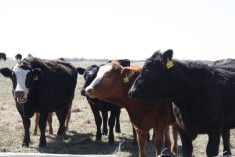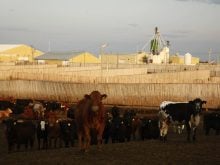prices up on fed steers
Canadian fed steers last week averaged $187.06 per hundredweight, up $2, and heifers were $185.36, up $1.69.
Dressed sales were $314-$315 delivered, which was about $74 higher than last year at the same time.
The cash-to-futures basis narrowed to -$5.21.
American packer interest was not as strong as expected, and few if any western Canadian cash cattle traded south.
Weekly western Canadian fed slaughter to Jan. 31 fell seven percent to 28,171 head.
Weekly fed cattle exports to Jan. 24 fell 11 percent to 3,025 head.
Read Also

Flax sector sees omega-3 opportunity
SASKATOON — A global shortage of omega-3 oils could be an opportunity for the flax sector, says an industry official….
Fed exports are down 57 percent so far this year.
Prices for live cattle in the southern United States in light trade at the end of the week were US$2-$3 per cwt. higher than the previous week at $160-$162.
In the north, dressed sales were $2-$4 higher at $255-$256 per cwt.
Moderate market-ready inventories in Canada should allow packers to slow slaughter to try to drive beef prices higher, but consumers might resist higher prices when pork prices are falling.
Cows post records
New record high cow prices were posted with D1, D2 cows at C$125-$145 to average $135.92, up $2.04.
D3 cows were $112-$129 to average $119.63, up 63 cents.
Rail grade cows were $257-$262.
A mostly mild winter means there has not been heavy demand on producers’ feed stocks, so there should be no pressure to rush sales of cows and bulls.
Cow slaughter had been less in the last few weeks than the same time last year, when the severe cold pressured early marketing.
Alberta D1, D2 cows were trading at a premium over U.S. utility prices, which could slow export demand.
Cash feeders rise
Relatively light feeder volumes trading through auctions were met by firm demand from feedlots, those who want to background on grass and the export market.
Western Canadian calf and feeder index prices strengthened $2-$3.
However, the Chicago feeder futures market fell with March now below US$200, the lowest level since the beginning of June.
At expiry, the Chicago January contract was trading nearly $9 higher than the March contract. The Alberta cash to futures basis has changed with the shift to March.
The 850-pound basis levels closed the week at -$9.96, compared to the five-year average of -$14.24.
It was the strongest basis since September 2012.
Auction volumes in February are anticipated to be larger than January following the normal seasonal trend, but the volume is anticipated to be well below the four-year average.
There is a premium for breeding quality heifers, with prices comparable with steers. Bred cows were $1,800-$2,850 a head.
Beef lower
U.S. beef cutout values continued to fall, with Choice down US$3.41 at $241.18 per cwt. and Select down $2.95 at 235.39.
Montreal wholesale price for delivery this week rose to C$318-$320 per cwt.














